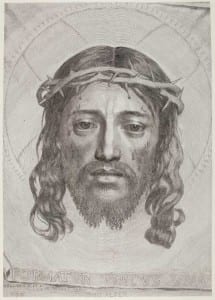The eyes have it
By Subhadra Das, on 2 August 2011
Spoiler Alert! This blog entry is about a UCL Museums & Collections cross-collections exhibition currently on display in four wall-mounted cases in the North Cloister of UCL. One of the cases contains a montage of 100 images of eyes from works in the UCL Art Museum, and contains a puzzle for you to solve. If you’re within viewing-distance and would like to play the game, look away now. Or, you can read on to discover more…
The eyes have it has been designed as a showcase exhibition for UCL Museums & Collections and exhibits include objects from the Grant Museum, Art Museum, UCL Pathology Collections and the Regional Planetary Imaging Facility, which is part of UCL Earth Sciences.
UCL Art Museum seldom contributes actual objects to the North Cloister display due to the light conditions (there is no way of controlling these in this space and excessive light is damaging to artworks), but we can contribute reproductions. Given that the exhibition was a chance to show off the collection, I decided that instead of tastefully positioning a handful of images around the cases, it would create greater impact to cram 100 into a single case. As the theme was eyes, I cropped 100 different eyes out of a selection of digital images of the collections and put them together in what I proudly call the ‘Art Museum Argus’ (named for a giant from Greek mythology who had a 100 eyes… we’re quite literary at the Art Museum). With the exception of a single pair, each eye comes from a different figure in a range of prints, paintings and sculptures held by the museum.
If you’re desperate to know the answer, here it is: the single matching pair of eyes in the ‘Argus’ belong to this artwork. It is an engraving entitled The Sudarium of St. Veronica by Claude Mellan (1598 – 1688), and dates to 1649. In an astonishing demonstration of skill, Mellan depicted the face of Christ using a single line spiraling outward from the centre of the work. The varying thickness of the line creates shape and tone. French by birth, Mellan studied and perfected this technique in Rome, where he lived from 1624 to 1636.
The title tells us that this is the face of Christ as it appeared on the cloth which St. Veronica used to wipe his face as he carried the Cross to Calvary. It is one of a series of 14 events along the Way of Sorrows – including when Simon of Cyrene carried the Cross for Christ, when Christ met his mother Mary, and the Crucifixion itself – which are collectively known as The Stations of the Cross.
If you’re interested to learn more about any of 98 other eyes in the Argus, drop me a line!
 Close
Close



